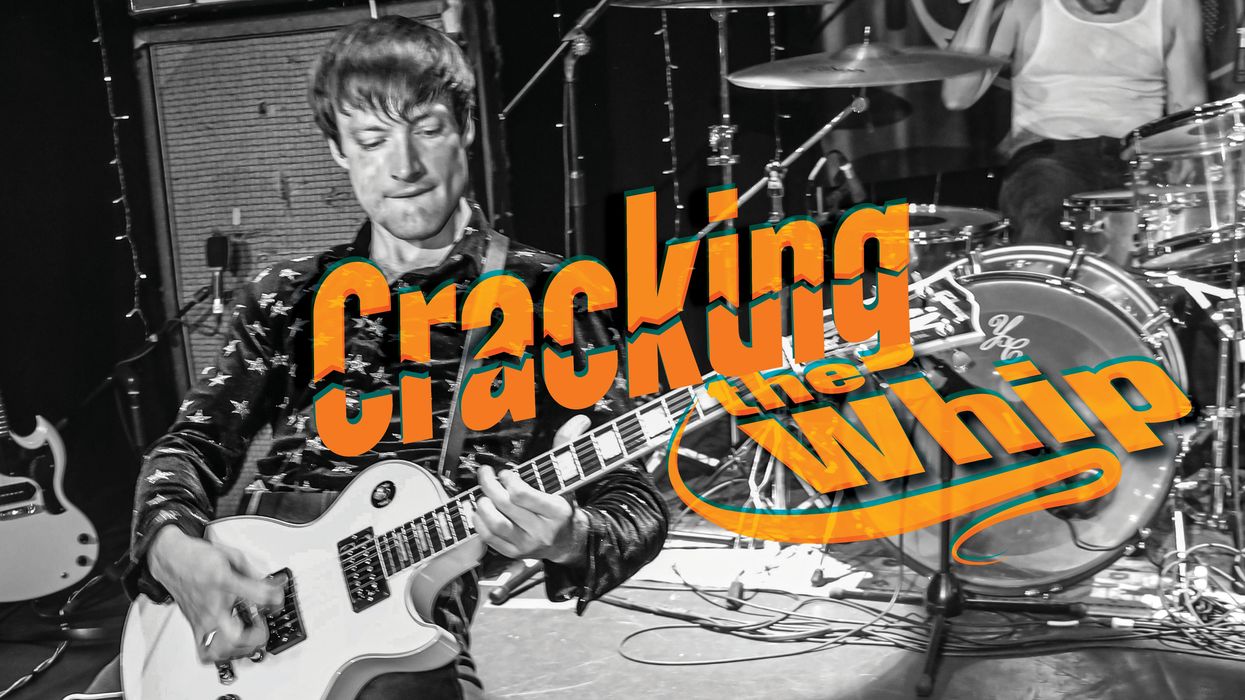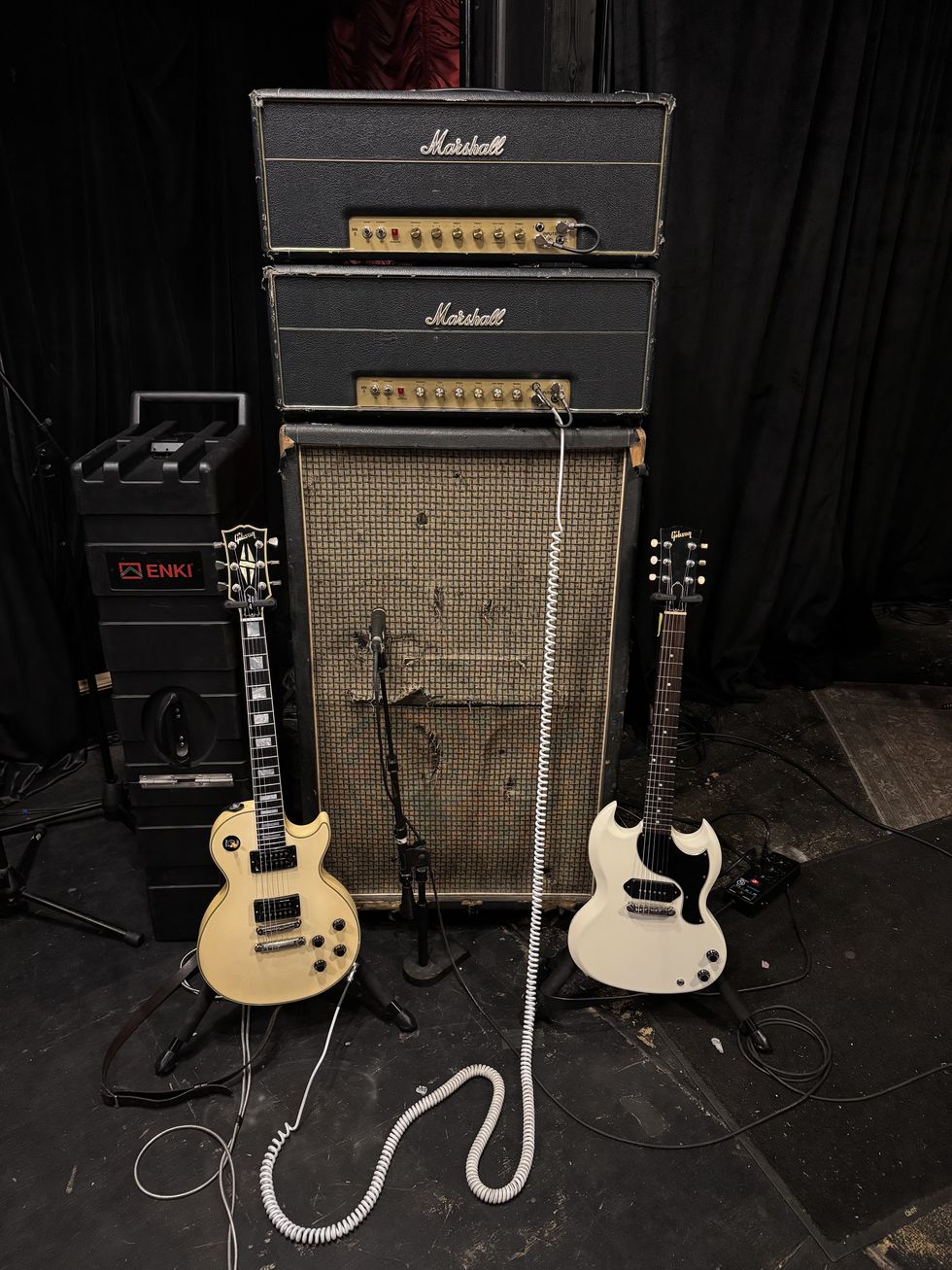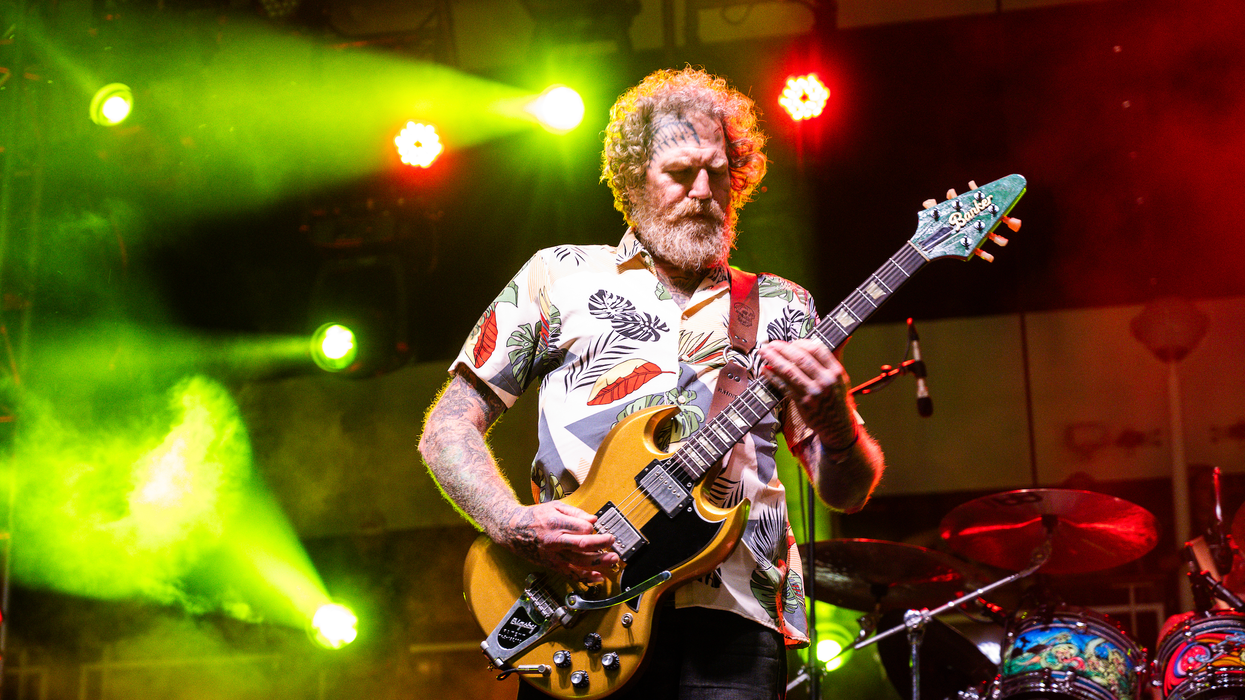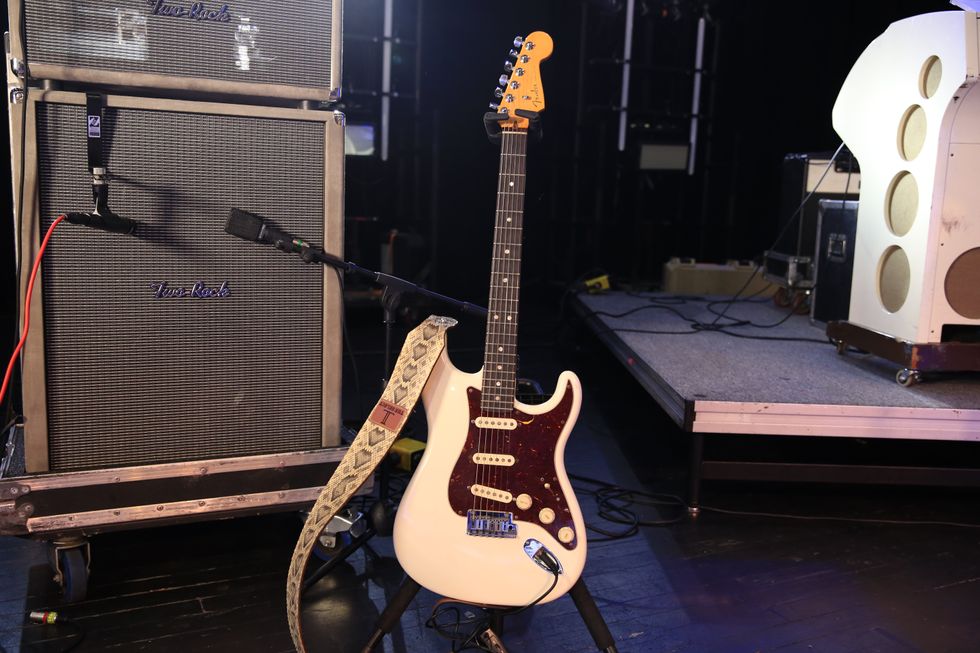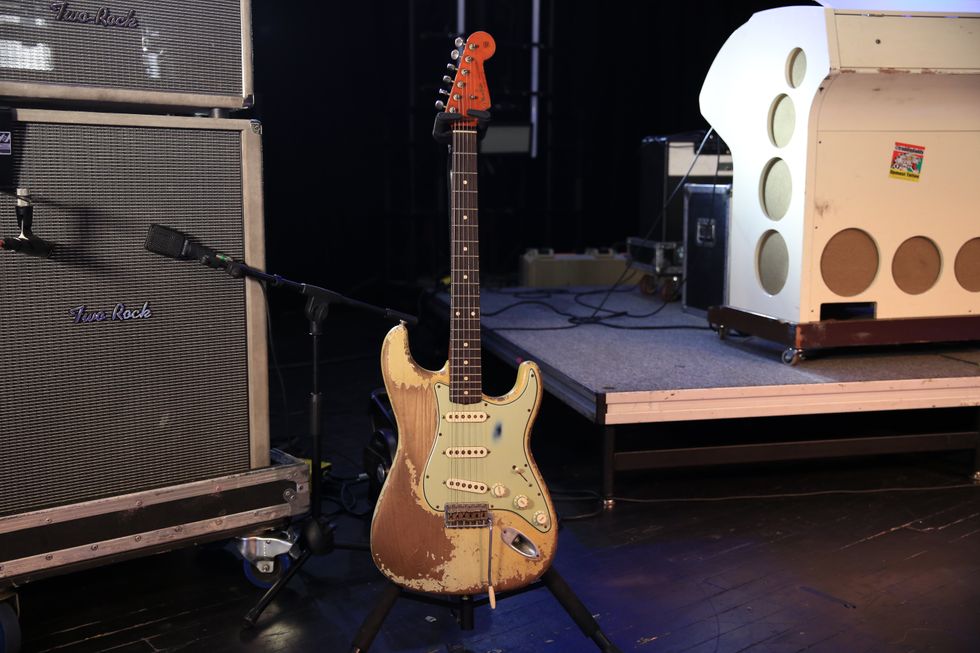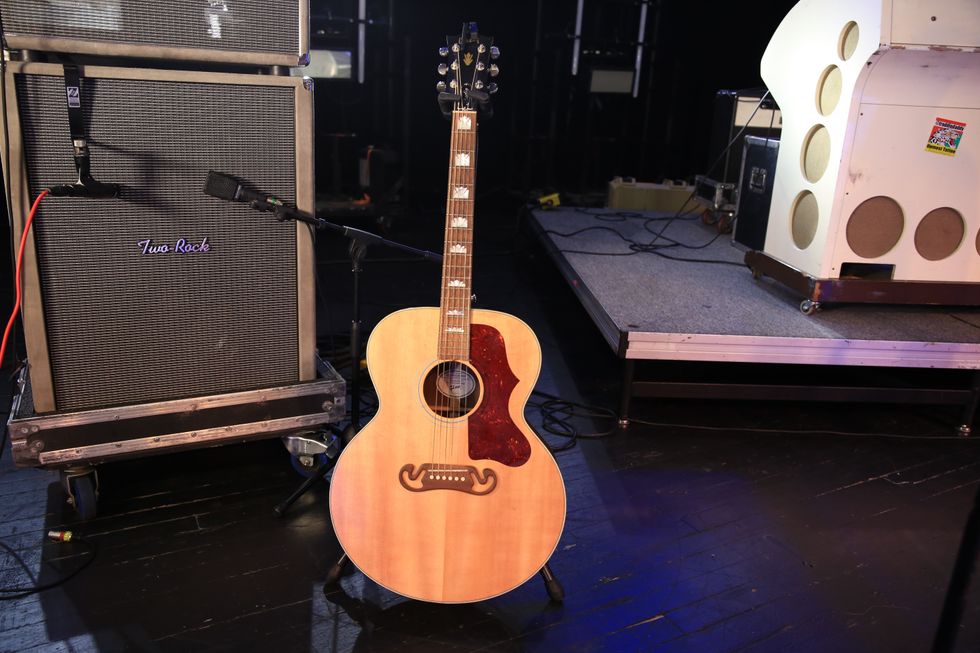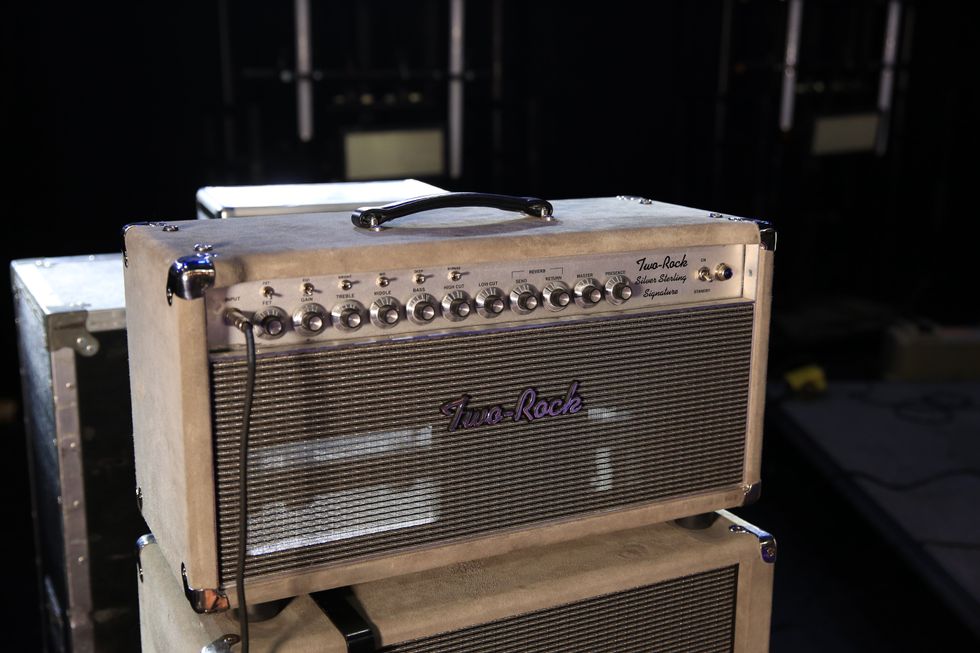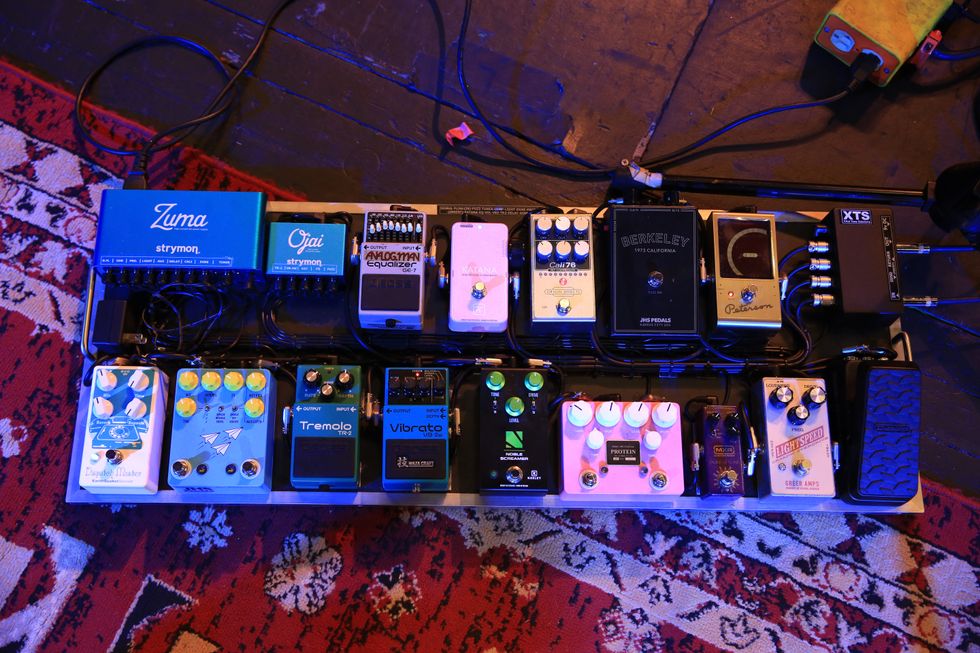Photos by Shervin Lainez
At 16, Joanne Shaw Taylor started turning heads with her smoky vocals, gutsy guitar riffs, and snarling solos. The English guitarist first emerged playing feral Tele in one of Dave Stewart’s post-Eurythmics bands called D.U.P., and it wasn’t long before Taylor made her solo debut with 2009’s White Sugar. At the 2010 Blues Music Awards, she earned Best New Artist Debut for that album, which she quickly followed with 2010’s Diamonds in the Dirt. At the 2011 British Blues Awards, Taylor scored two more prestigious honors—Best Female Vocalist and Songwriter of the Year—for “Same As It Never Was,” a song from Diamonds in the Dirt.
For her latest solo album, Almost Always Never, the 26-year-old decided to head in a new direction. Rather than return to Memphis to work with Jim Gaines [Eric Johnson, Carlos Santana, John Lee Hooker, Buddy Guy, Stevie Ray Vaughan], the legendary producer behind her first two discs, Taylor enlisted Mike McCarthy and tracked in his Austin studio with a band he assembled for the occasion. As a result, Almost Always Never has less to do with Stevie Ray and Albert Collins—two of Taylor’s blues influences—and instead offers a more exploratory vibe with extended solos, deep grooves, and experimental tones.
We asked Taylor to take us through this musical transition and describe the creative process that birthed Almost Always Never.
This album is a departure from your
previous two releases. Instead of blues-based
rock, you take a more experimental
approach—even exploring psychedelic
jam-band territory. What drew you in
this direction?
Two things made this one different. First
off, I had more time to make the record. For
both White Sugar and Diamonds in the Dirt,
I had a 10-day window to write the songs
and another 10 days to record them. So
those albums came together very quickly.
But last summer I got a series of ear
infections that left me temporarily deaf and
unable to perform, so I was essentially stranded
where I was staying in Houston, and I
had a bunch more time to write songs for the
new album. I’d never had this opportunity
before. Once I’d written what I thought was
an album the label wanted to hear, I still had
a lot more time, so I wrote another batch of
songs. Some for myself, some for other artists—all kinds of stuff. When it finally came
time to start the new album, I bit the bullet
and went sod it, I’ll send over all the songs
and see which ones get picked.
The second major difference was that we used a different producer this time. I’d always worked with Jim Gaines, who I actually love and adore. But this time we decided to shake things up a little bit—more for me, you know, to force me into a challenging situation. Mike McCarthy produced Almost Always Never, and that accounts for the different musical approach. I’m the sort of person who gets very comfortable and doesn’t like change, so the idea of having someone new to work with who I didn’t know was quite terrifying, to be honest.
How did you connect with him?
It was one of those lucky things, really. I
like to be involved in that kind of stuff—I’m a little bit of a control freak—so my
manager suggested Mike. I Googled him
and saw his resume, which includes Spoon,
And You Will Know Us by the Trail of
Dead, and Patty Griffin. I thought, you
know what? That’s right up my street, in
that those are some of my favorite artists
and that’s the kind of music I listen to. But
it’s not generally what I want to sound like,
and that I found very intriguing.
He’s based in Austin, so when we had a gig there, I drove over to his studio one afternoon and checked it out. He’s a very quirky guy—I’m sure he was British in a previous life—and we just hit it off. Mike is from a totally different school than me, but we also had things in common. He’s a big Jimmy Page fan and he likes some of the classic British rock I grew up with. I saw we had enough in common to make it work and enough not in common to make it interesting. It turned out well and was a really good experience for me.
Did he select the other musicians?
Yes, he brought in studio guys he regularly
uses—[drummer] J.J. Johnson, [bassist and
slide guitarist] Billy White, and [keyboardist]
David Garza. Fortunately, I knew of
all these musicians and was a huge fan of
their playing. In fact, I was so impressed
with their careers I got quite nervous about
going into the studio.
Describe the tracking process and how it
compared to White Sugar and Diamonds
in the Dirt.
On the previous albums, the goal was to
capture live drums and bass. I’d jam along
to show them the changes, but I’d redo all
my guitar parts later. This time we actually
cut all of my rhythm playing and even
some of my vocals live with the band over
the course of three days. On “Jealousy” and
most of “Standing to Fall,” we had such a
vibe going live in the studio that when we
tried to redo the guitar solo and vocal, it
didn’t match the atmosphere we captured
when the band was there. So we kept those
as live takes. I played in the same room as
J.J. and Billy, and David was in a separate
keyboard room.
How did working with a keyboard player
affect your rhythm playing and soloing?
That was another different thing about this
record. I’ve had a trio for a long while, so it
was a brand new experience working with a
keyboard player of David’s caliber. Having
not worked with many keyboard players,
I didn’t know what he was going to do.
Give us an example.
Mike would come in and go, “Joanne, I
know everyone else thinks it’s great, but
you’re playing too much.” [Laughs.] I hate
to admit it, but that was the situation. I’m
used to working with a three-piece, so I’m
trying to be Jimi Hendrix over here, but
when you’ve got a keyboard player, you
don’t need that.
The last track on the album, “Lose Myself to Loving You,” I wrote as a ballad, and there was a gap in the middle we’d left open for the token guitar solo. But once we’d tracked the song, we all agreed that a big, wailing Eddie Van Halen guitar solo could ruin it. David’s piano was so beautiful, it completed the song as far as I was concerned, so we left it alone and let the piano show through. It was really nice to treat a song as more than an excuse for a guitar solo.
Did Mike hear the songs you were
hoping to include on the album before
you went into the studio?
Yes, I’m kind of the queen of Garage
Band, and I just demo everything out. I
put the bass down myself, along with all
the guitar parts and vocals. When Mike
and I first got together, I did my usual
thing of giving him my Garage Band
demos, so he and the band could know
how I was hearing the music. He got
back to me and said, “Yeah, that’s not
what I want. I just want you and a guitar
in a room.” And I panicked because
I’d never done that before—to be honest,
it scared me senseless.
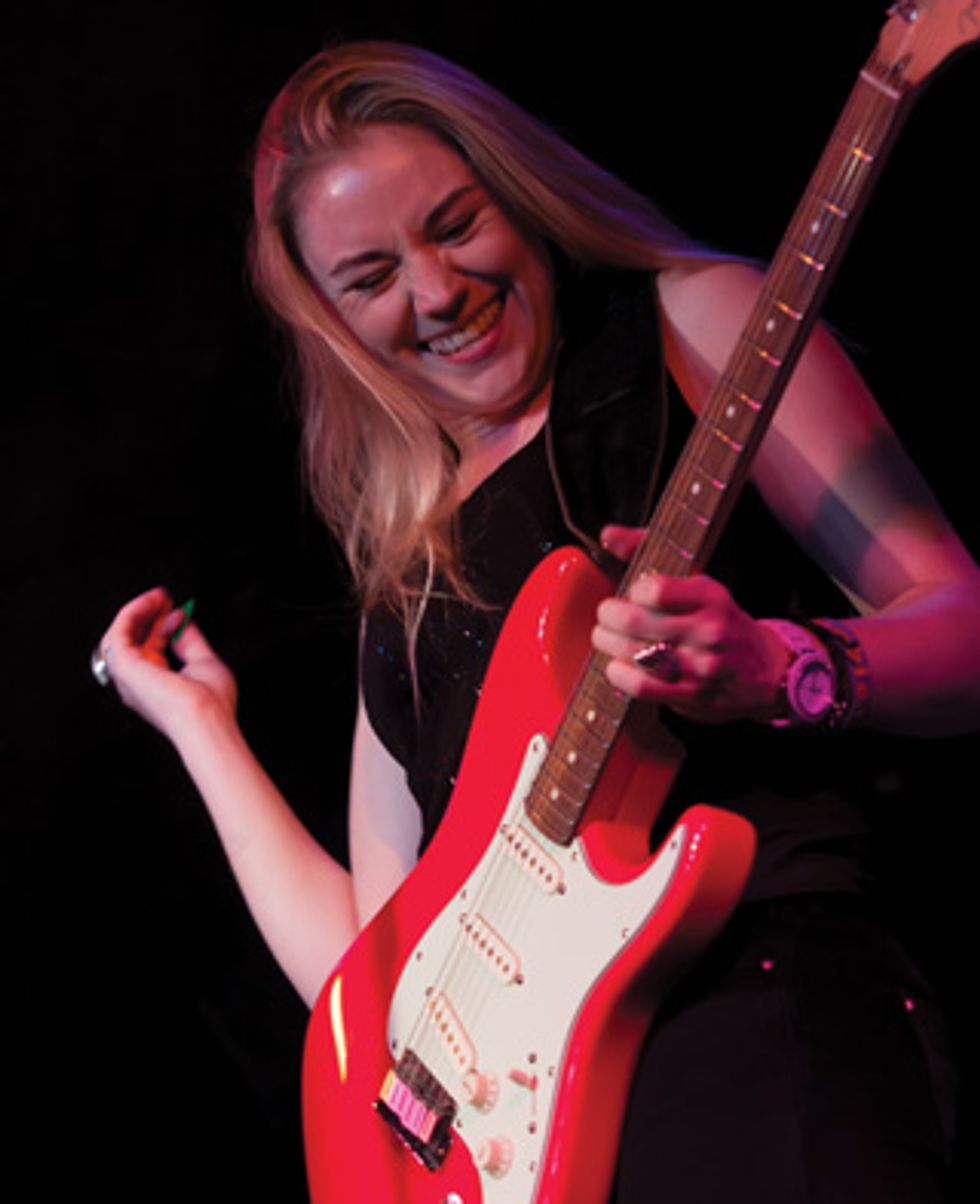
JoAnne Shaw Taylor has a blast onstage with a recentvintage Fender Strat. Photo by Rob Stanley
Why?
I wasn’t sure if I was a good enough
writer that the songs would stand by
themselves if I didn’t have all the instruments
on them. But he seemed to think
so. So I just recorded them in the hotel
room with me playing guitar and singing
over the top.
How many songs did you give him
to listen to?
I think I ended up sending Mike about
20 songs, and we cut 12 of them. But
the odd thing was, three of them I
wrote in the hotel the night before we
went into the studio—“Tied & Bound,”
“Lose Myself to Loving You,” and
“Beautifully Broken.”
You wrote three songs the night before
the session?
Yeah, but I wouldn’t advise that to anyone.
The one thing I know about myself
is that I tend to come up with songs at
the last minute. As soon as the pressure
is off because I know we’ve got enough
material for the album, I quickly add
new songs to the list. For White Sugar,
I wrote three songs on the plane on the
way over to Jim’s [Gaines] house. It’s almost
to the point where my producer should lie
to me and tell me the sessions are scheduled
a week before we really begin.
How can you even remember three songs
you’d written the night before?
It was a bit of a challenge. When we got in
there, everyone was looking at me because
I didn’t know the changes very well. I had
to keep telling them, “Come on, I just
wrote this last night.”
Compared to your previous two albums,
the songs on Almost Always Never seem
to unfold at their own pace and offer you
more time to explore the fretboard.
When I was forced, for health reasons, to
have this time off last summer, I reverted to
being my 13-year-old self and just played
guitar every day. This period allowed me to
get excited about guitar again. I know this
sounds terrible, but when you’re a professional
guitarist playing 200 dates a year,
you can lose sight of what got you started.
When I was 13 in my bedroom looking at
posters of all my idols, I’d pretend I was
them. And I got that feeling again. When I
went in the studio this time I had a bunch
of new licks and was really excited to mess
around with new tones.
So there were some fresh influences on the album, but more to the point, there were old influences I’d dug up again. I took a trip down memory lane and spent a lot of time listening to guys like Eric Johnson, Richie Kotzen, Paul Gilbert, and Gary Moore. In terms of bands, I went through a big King’s X phase around that time. It seems odd to me now, given how the record turned out—not like King’s X—but that was what I was listening to ... very guitar-based rock.
You’re pictured with a Les Paul on the new
album and while there are some Fender
sounds on the tracks, many of your solos
and riffs have a fatter tone than before.
Did you switch from your Tele to a Les
Paul for a lot of these guitar parts?
I did. Some folks at Gibson had heard my
music and they lent us a Les Paul for the
recording. It was perfect timing—I was
playing new material with a new producer
and a new band, so why not try a new
guitar? I absolutely fell in love with the Les
Paul they loaned me, but unfortunately
they wouldn’t let me keep it. And being
female, I’m pretty sure once they told me
I couldn’t have it, that’s when I decided I
wanted it. [Laughs.]
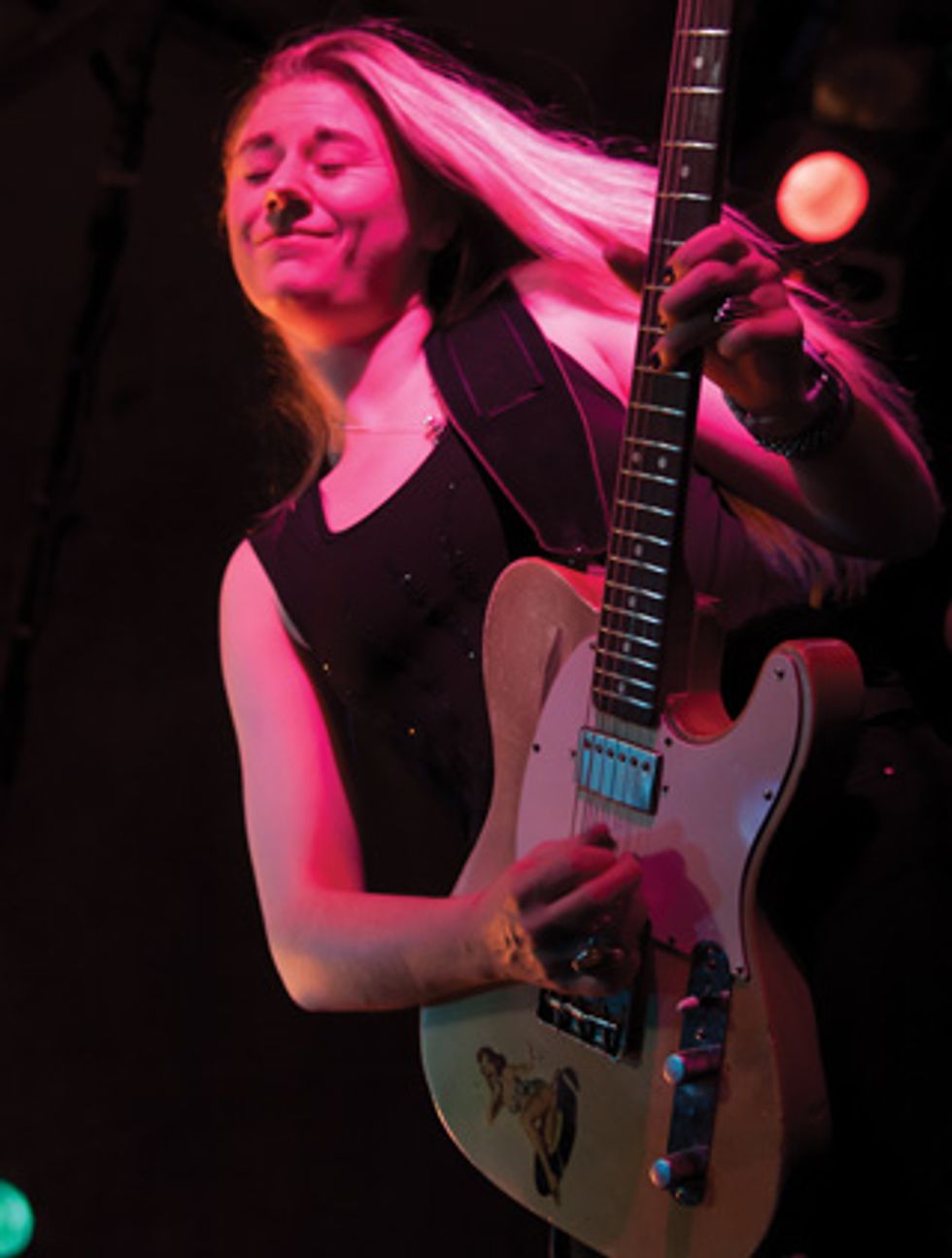
Taylor says her mother wasn’t too pleased that her teenage daughter played an Esquire with a pinup girl on it, but she softened a bit when Taylor played a gig with Annie Lennox for the Queen. Photo by Rob Stanley
Did you also try a different amp?
Yes. Though Billy [White] played bass on
the album, his main instrument is guitar.
He played with Don Dokken and in
Watchtower, and he’s kind of a shred god.
Anyway, he brought in his ’72 Marshall
50-watt head and 2x12 for me. At that
point, with everything else being new and
different, I thought, “Why not? Let’s go
for a different sound.” The funny thing
was, although I was going for Eric Johnson
and Gary Moore, I think I still ended up
sounding like me.
I have no qualms telling you I fell in love with that Marshall, and I’m hell-bent on getting one. A ’72 50-watt Marshall is really the holy grail—you put a nice Les Paul through it ... well, it’s perfect.
Any other amps?
Mike had an old ’60s Silvertone we used
a lot for the rhythm. That and Billy’s
Marshall for lead were the two main ones I
used for everything. We had both amps in
a separate room—a big space at the back
of the studio. I could just about hear the
Marshall from where we were situated, so
I’m pretty sure it was on 11.
Is that a Stratocaster on “Lose Myself ”?
Actually that’s a Music Man. My boyfriend
has a fine array of guitars and I stole it
from him. It has a nice glassy tone that just
seemed to work on that track. We used
Mike’s Harmony Master—a 1960s hollowbody—
a lot. I used a bunch of different
stuff I’d never used before, whether just
from not being comfortable with a piece
of equipment or feeling there were rules I
shouldn’t break. I think I only picked up
the Telecaster once or twice, which was
quite fun in a way—a busman’s holiday.
What sort of rules are you referring to?
Well, I didn’t want to upset fans who know
me as a Tele player. But then I realized the
sound is really in your hands, and there’s
no harm in trying to inspire yourself with
a new instrument or go for a slightly different
tone. That was a fun lesson to learn.
Did you use an octave fuzz on the solo
in “Soul Station”?
I did. Mike had a bunch of toys, so it
was a time of experimentation. That
octave fuzz is a Death By Audio pedal
called the Octave Clang, which I love.
When we cut that track Mike said,
“What are you thinking of for the solo?”
After hearing what J.J. did on the drums,
I said, “I pretty much want it to sound
like guitarmageddon.” He handed me the
Octave Clang and told me to plug it in.
After a few notes I said, “Yeah, that’s it.”
What about other effects?
Mike had an old Rat distortion pedal I
used for “Maybe Tomorrow,” which has
probably the weirdest solo on the album.
We had a vintage Boss chorus pedal, a vintage
MXR chorus pedal, and a Dimebag
Darrell wah-wah—my favorite wah—
hooked up for that. “Maybe Tomorrow”
was interesting because I wrote it as a very
up-tempo rock song and the lyrics were
completely different. I took it to Mike and
he said, “That’s not working for me.”

Joanne Shaw Taylor thwacks a 4th-string G while soloing on one of her Strats at a 2011 gig in Bilston, U.K. Photo by Rob Stanley
Ouch.
Yeah, exactly. So we got in with the band
and Mike said, “J.J., what are you thinking
of on this?” And J.J. slowed it down a
lot and made it into what it is—that kind
of Dr. John voodoo groove. It sounded
really good, but the lyrics didn’t fit with
the music anymore, so we left that to the
very last minute. As we were finishing up
recording, I wrote new lyrics that would
fit the new feel. At that point, the whole
song became a sort of improvisation. I
put down that riff and thought, okay,
what else can we add to it?
Out of all the songs, that was the one where we really didn’t know where we were headed. We just built it up by listening and seeing where it wanted to go. Mike had hooked up a Roland Space Echo and was making these weird sounds, and I basically decided I was going to play a couple of phrases and then intersperse strange noises from the Space Echo. We just went for some weird stuff, which was good fun. That song was very produced. Mike chopped and pasted guitar solos, and that makes it more of a piece than a guitar solo. It’s a jam song, all about the vibe.
“Army of One” sounds like you guys
were all just jamming in a circle around
a couple of mics.
We were, except we didn’t have the luxury of
a couple of mics. I think we had one. When
I wrote that song, I thought it was going to
sound like “Going Home” off the first record
and “Dead and Gone” off the second. Because
I have this fetish about writing traditional
blues lines I want to make modern, I always
write these evil blues songs I’d want to hear
in an episode of The Sopranos. Like you’re
driving through the city late at night and
you’ve got a body in your trunk. [Laughs.]
So this was another song like that, but Mike said, “Let’s make it acoustic.” And I said, “Really?” It was the last song we cut. We all went out together to dinner that last night and had a glass or two of wine, and then stopped by the liquor store on the way back to the studio and bought some tequila.
I see where this is going.
We all sat in this one little room. J.J. is on
the marching drum, Billy is playing slide,
David is on the mandolin, and then there’s
me on a hollowbody. Mike came into the
room—he’s the one you hear at the beginning
of the song telling us what the tempo
is because we’d all gotten so excited and
unruly we weren’t quite doing the job.
He had to come straighten you out.
Exactly! Dad had to come in and ruin the
fun. But we did the song in one take. It was
very organic, very last minute—a late-night
studio bonding experience. That song is one
of my favorites for sentimental reasons.
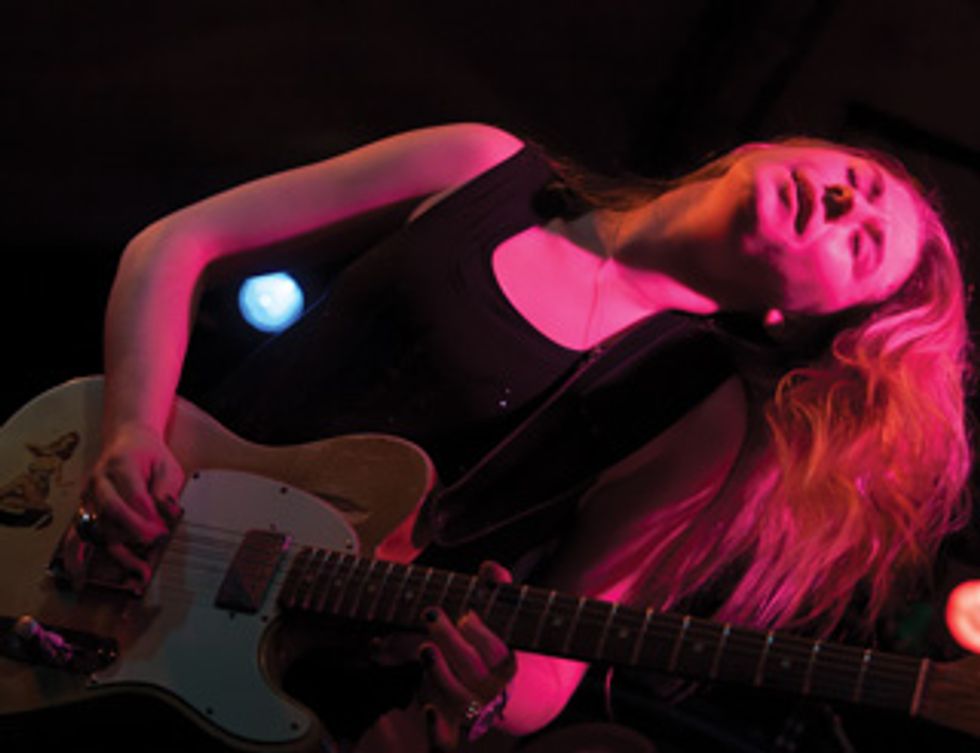
Taylor bought her ‘66 Esquire on London’s historic Denmark Street when she was 15, and had a Seymour Duncan Jazz SH-2 placed in the neck. Photo by Rob Stanley
What guitar were you playing?
The hollowbody Harmony through a tiny little
amp—some 5-watt model Mike picked up
in Japan. We had it cranked but it just wasn’t
putting out. Most people think it’s a resonator,
actually. Half the time I tell them it’s not and
half the time I let them believe it is because I
don’t want to correct people. [Laughs.] That
guitar ended up fitting the song quite well.
I don’t think it sounds like an out-and-out
electric. It’s a welcome break on the album,
and I’ve never done an acoustic track before.
Tell us about the gear you use onstage.
I have my two staple guitars. One is a 1966
Esquire, which I’ve had for years and years—it’s my first guitar. When I was 15, I bought
it in London on Denmark Street [a historic
stretch of road known for its music shops
and recording studios]. At the time I was real
scared that my dad was going to beat the hell
out of me for taking a train down to London
at 15 and buying a ridiculously expensive
guitar with all my pocket money. But I got
it cheap because the previous owner had
attacked it with a knife. It had a gaping hole
near the neck, so I had a guitar tech dig it
out and add a humbucker there. That made
it kind of my dream Telecaster.
What humbucker?
A Seymour Duncan Jazz [SH-2].
Is this Esquire your guitar with the pinup
girl on it? And if so, did you put that on
or was that from the previous owner?
Yeah, that’s the one, and I added the pinup girl.
My mother wasn’t very happy with that—in
fact, she was a little worried. You know how
moms are: “Why is my daughter putting a
picture of a pinup girl on her guitar? And why
is she playing guitar anyway?” Try being 15 and
attempting to explain to your mom why there’s
a half-naked lady on your guitar. It wasn’t
her favorite part of my youth, but she’s used
to it now. Moms just don’t get rock ’n’ roll,
that’s what I’ve learned, but I think the Annie
Lennox gig soothed mom’s issues. [In June
2012, Taylor played lead guitar in Lennox’s
band for a huge televised Diamond Jubilee
Concert in London honoring the Queen.]
Then there’s my Dave Stewart Telecaster, which I’ve had on permanent loan for a decade. It has a Warmoth Tele body, which has a belly cut like a Strat, and a ’55 Fender maple neck. That guitar is so heavy, it sounds like a cross between a Tele and Les Paul.
I’ve seen recent photos of you onstage
with a Les Paul.
Yeah, that’s a new addition. It’s a 2008
Custom Shop model. A little bit lighter
than most—about nine pounds—with a
’60s neck. With my teeny, tiny girl hands,
I can’t play the big ol’ ’50s baseball-bat Les
Paul necks.
Those are my main three guitars. I’ve got a bunch of odds and sods, the kinds of things I go into pawnshops to find. They’re dirt cheap and I like them. I’ve got a Squier 51—Fender’s answer to a Telecaster/Strat hybrid—that’s worth about 100 bucks. I installed a Seymour Duncan Pearly Gates and pimped it out a little bit. Also a ’92 Tele and an ’88 Tele, which are both pawnshop finds, and then a couple of standard Strats, including one my grandmother bought me. They’re pretty standard, though I’ve replaced the pickups in most of them.
And stage amps?
Live, I’ve been using a Louis Electric
KR-12 combo and a ’65 Bassman head
driving a 2x12 Marshall cab with standard
Celestion Greenback speakers. The
Bassman has been modded to ’62 specs,
and I use it for clean rhythm sounds like
on “Beautifully Broken,” “Lose Myself to
Loving You,” and “Diamonds in the Dirt.”
I’ve always been a huge fan of Bassmans. I
love the ’62 cream Tolex Bassmans—I just
think there’s nothing more beautiful. Even
if I ever have a child, I think I’d find the
Bassman more beautiful.
What does your pedalboard look like?
At the beginning of this year, I decided to
strip down my pedalboard. I’m a typical
guitar player, so I’ve gone through a bunch
of phases. I’ve had a pedalboard the size of a
Hammond B3, and it’s not fun to tour with
and lug around. So now I play through a
little board. I keep one in Australia, one
here in the U.S., and one in Europe, and
they’re all pretty much carbon copies.
I use three pedals from Mojo Hand FX—a Recoil Delay, a Colossus Fuzz, and a Rook Overdrive, which has replaced my Tube Screamer. Other than that, I have a Way Huge Aqua Puss delay, which I use for slapback, and an MXR Dyna Comp, one of the old models. These pedals give me pretty much everything I need. I’ve also added a Death By Audio Octave Clang for the solo on “Soul Station.” Between the amps and different guitars, five or six pedals are all I need to get the tones I want. How about strings and picks? I’m a devoted fan of Ernie Ball strings— always have been. I use the Skinny Top Heavy Bottom sets, gauged .010–.052. I tune down a half-step—mostly for my voice, because I have a slightly lower register— and I used to play with .011s. But then I grew up and realized I have female hands and I’d have to stop playing in 10 years if I continued using big-boy strings. I don’t have Jimi Hendrix’s hands!
I’ve just started using the Dunlop Eric Johnson signature picks, the little jazz picks. I find those plectrums really help with righthand control. It’s not so much for speed, but for making sure the notes ring nicely.
Joanne Shaw Taylor’s Gear
Guitars
Customized 1966 Fender Esquire,
Warmoth T-style with ’55 Fender
Telecaster maple neck, 2008
Gibson Custom Shop Les Paul,
Fender Squier 51, various production
Fender Stratocasters
Amps
’65 Fender Bassman head
and 2x12 Marshall cab with
Celestion Greenback speakers,
Louis Electric KR-12
Effects
MXR Dyna Comp, Way Huge
Aqua Puss delay, Death By Audio
Octave Clang, and Mojo Hand FX
Recoil, Colossus, and Rook
Strings and Picks
Ernie Ball Skinny Top Heavy
Bottom sets, Eric Johnson
Classic Jazz III picks
In the liner notes for Almost Always
Never, you’re credited with all electric
guitars and vocals, as well as playing
something called Gordon on “Piece of
the Sky” and “Lose Myself to Loving
You.” What’s that?
Well, there’s some background to this
story. Mike puts his name on everything—every microphone has “property of Mike
McCarthy” on it, for example. When I took
that first studio tour, I looked around and
thought, okay, that’s the sign of a control
freak. After I got to know Mike I teased
him about it, saying it was like a child
going to school for the first time and his
mom puts his name in his underpants.
Fortunately he took it well.
One day when Mike and I were going over the songs before the band came in, he said, “I’ve seen this 1960s Gibson acoustic in Guitar Center and I want to buy it. The only problem is, the previous owner was obviously a kid and he put giant orange letters on it to spell out his name. It’s a beautiful ’60s Gibson with these really gross, plastic letters spelling Gordon.” I said, “Well, buy it anyway.” And the next day he brings that guitar in.
Do you know what model Gibson?
I think it was a J-45. So that’s what I played
on those two songs. It was just funny that
he found his dream acoustic guitar and
some kid had put his name across it in
giant orange letters. Karma. So Gordon is
just an acoustic guitar, but you have to call
it by its proper name.
YouTube It
To experience Taylor’s fretboard prowess, check out the following clips on YouTube:
Taylor tears into two songs from
White Sugar in a 2011 London show.
In another song from White Sugar,
Taylor pulls a sweet range of clean
and dirty tones from her Squier ’51 at
a festival in Wilmington, Delaware.
Annie Lennox features Taylor on lead
guitar at a massive 2012 outdoor
concert at Buckingham Palace in
London. Dig JST’s white outfit and
angel wings! And, of course, her Les
Paul and extended solo.

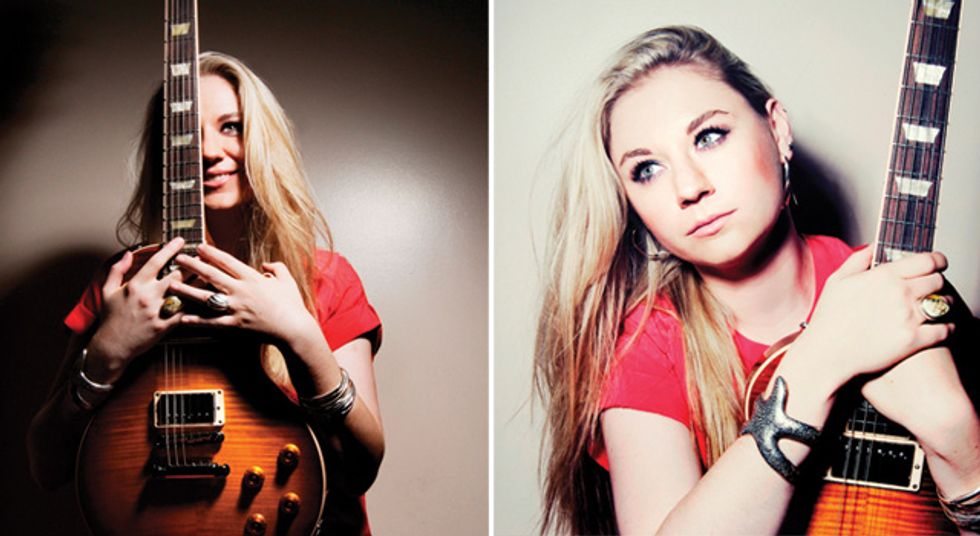
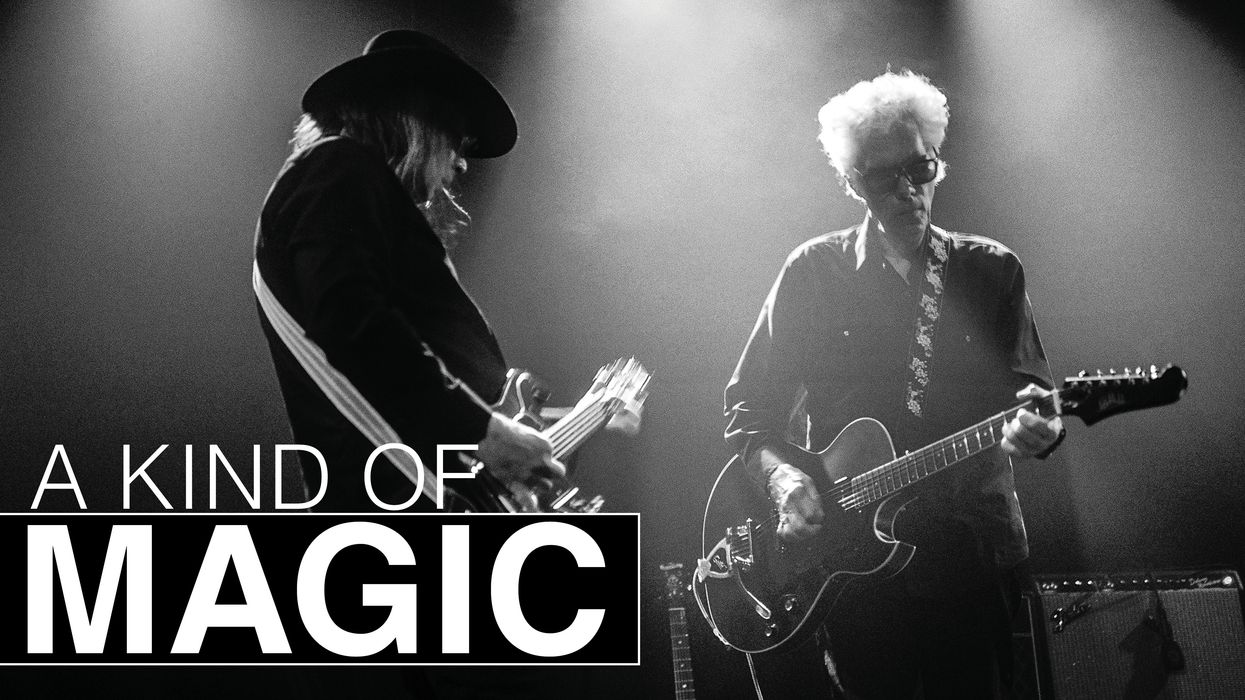
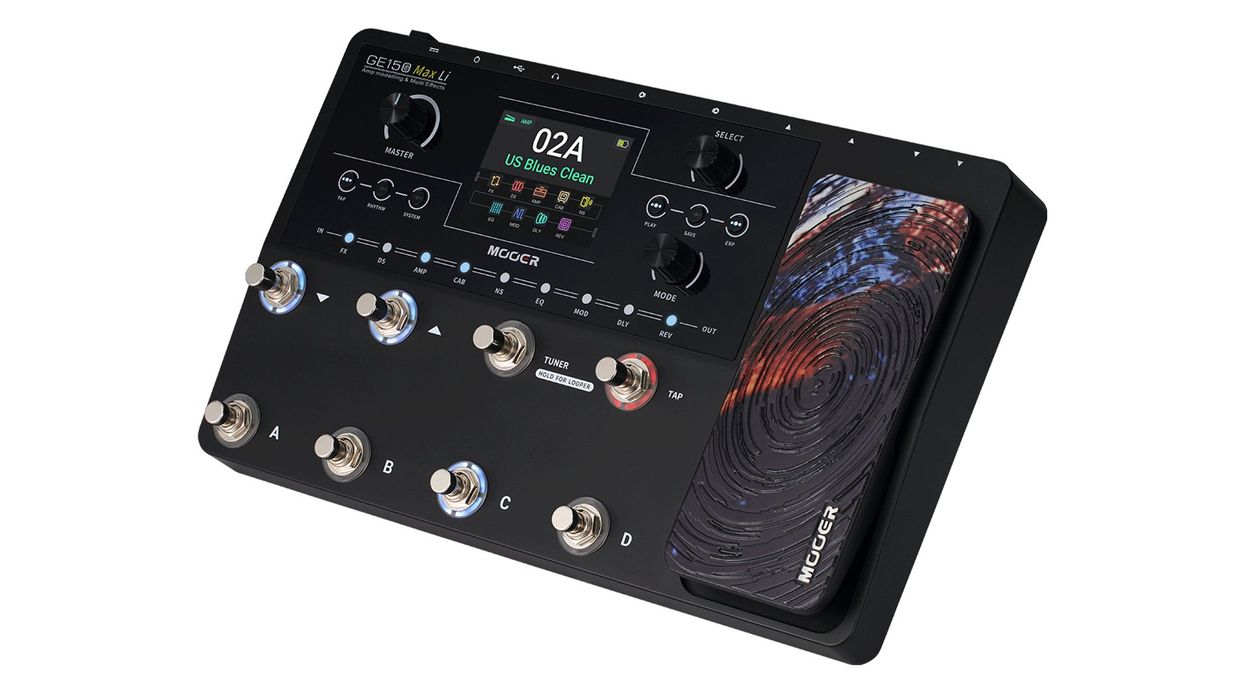
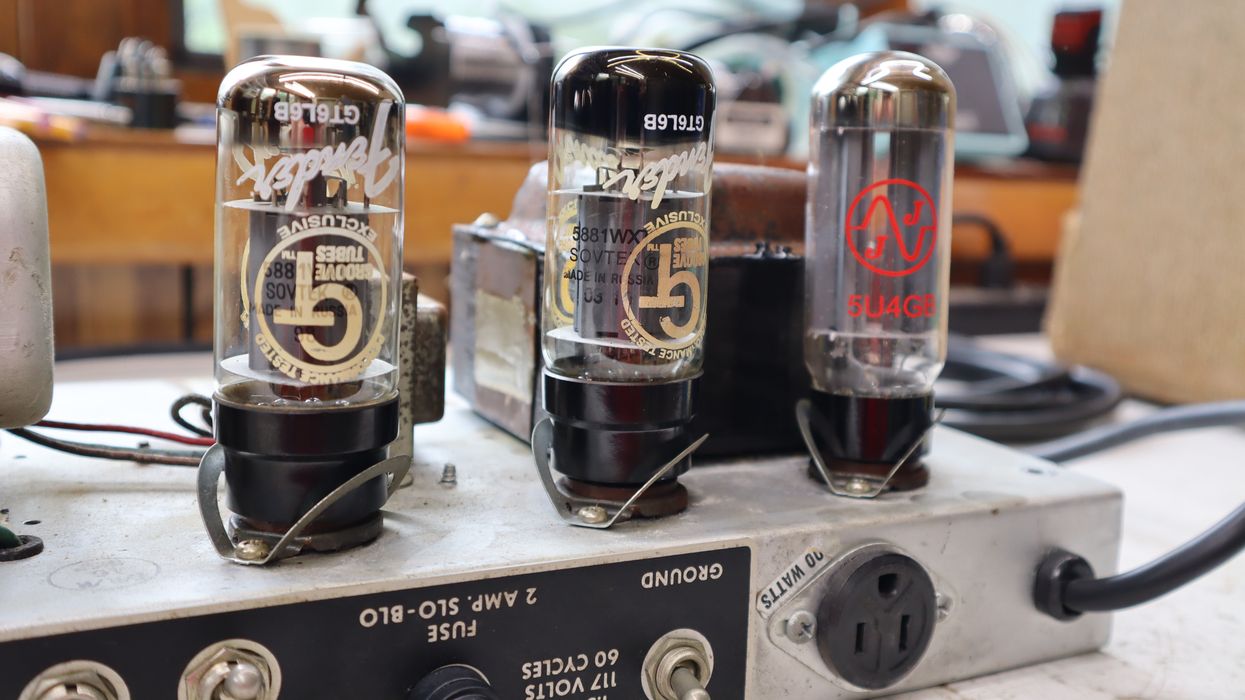
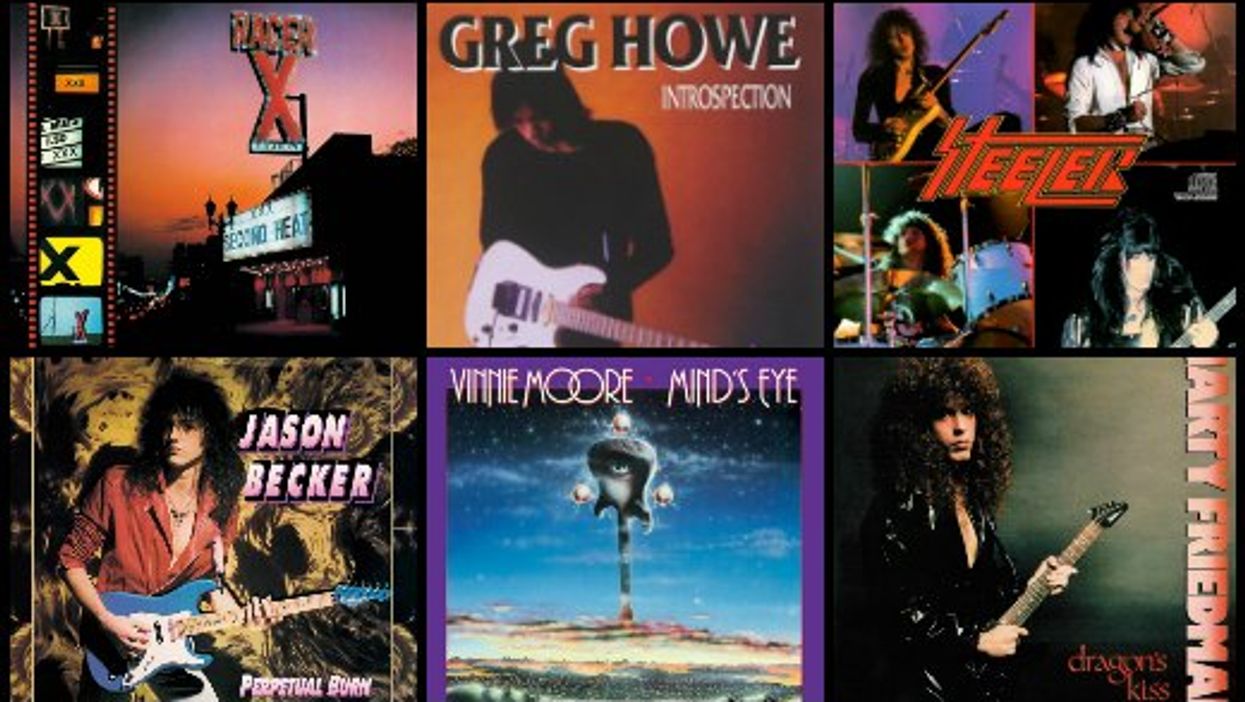
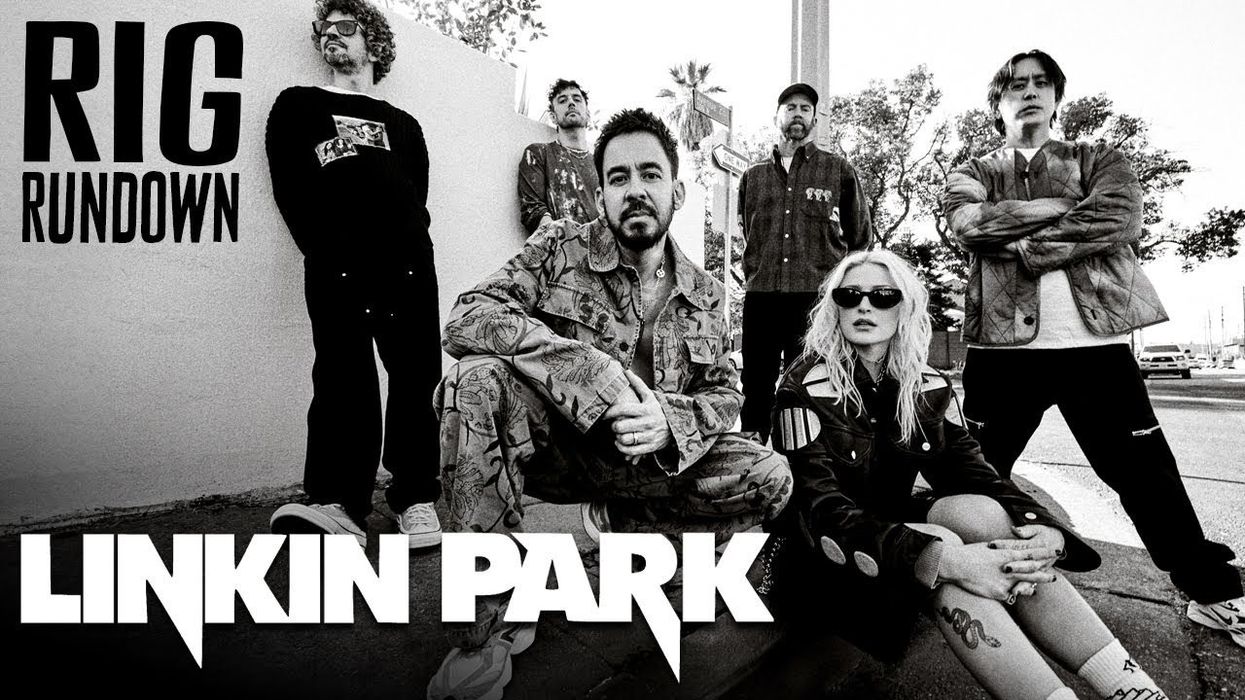
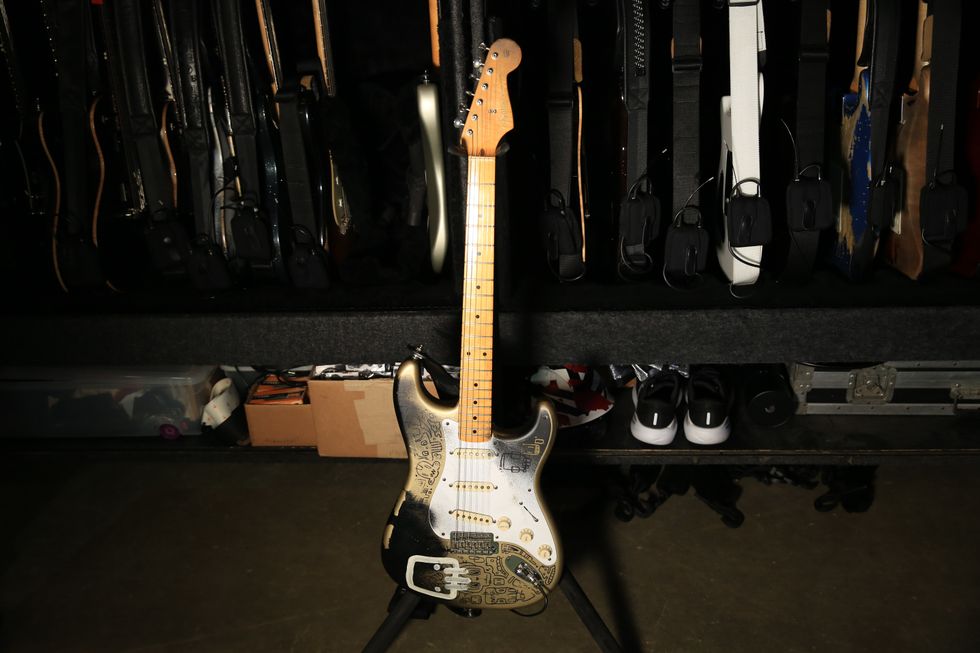
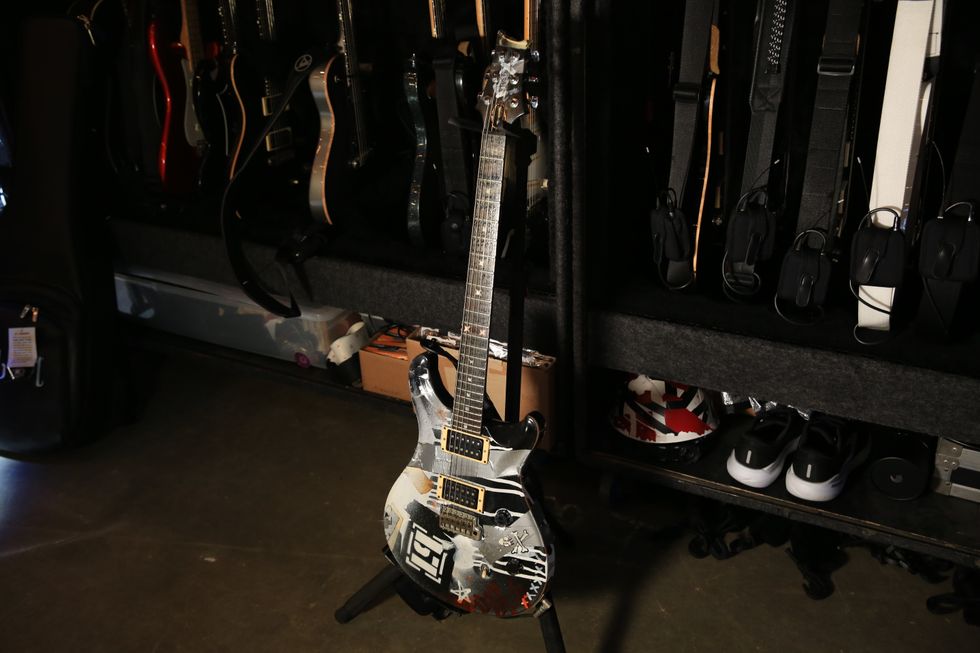
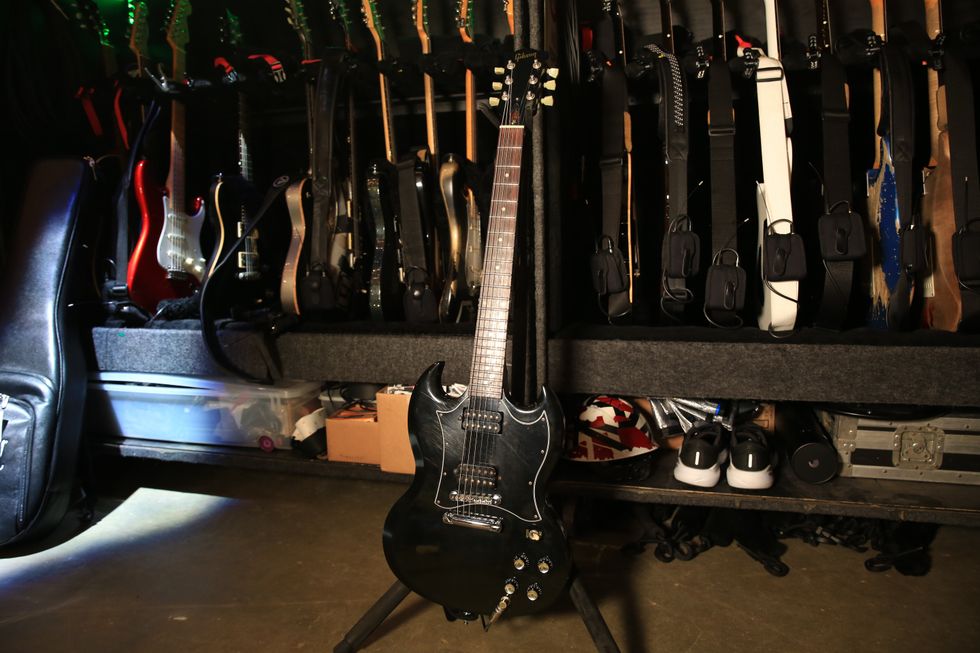

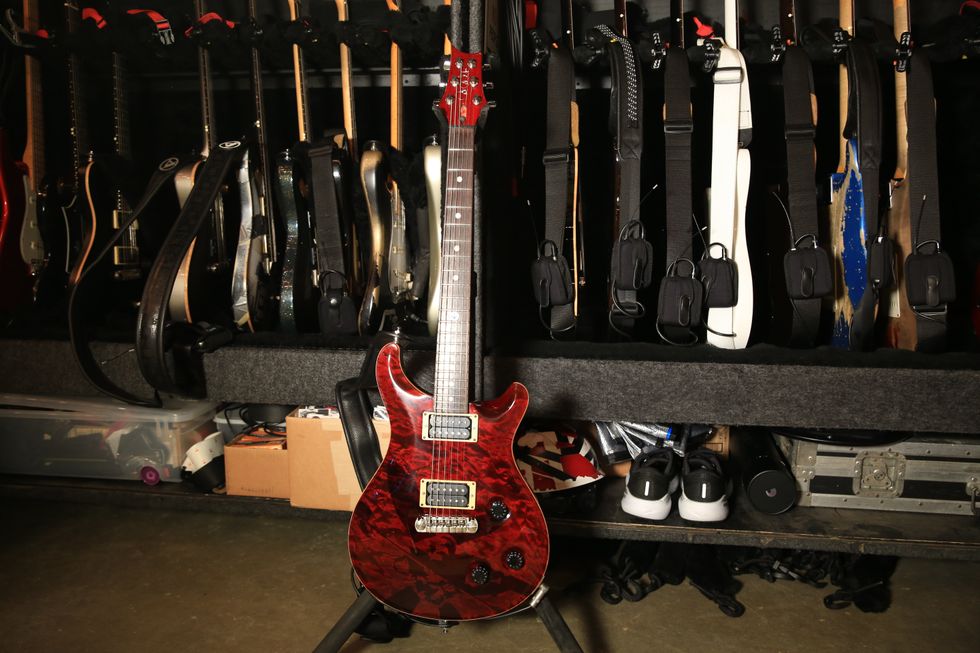
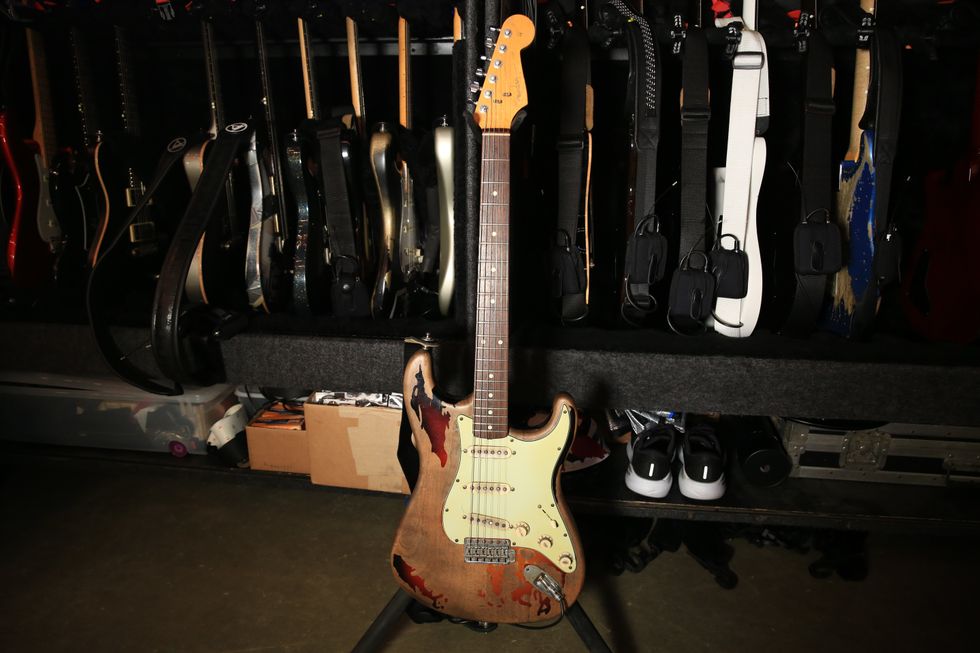



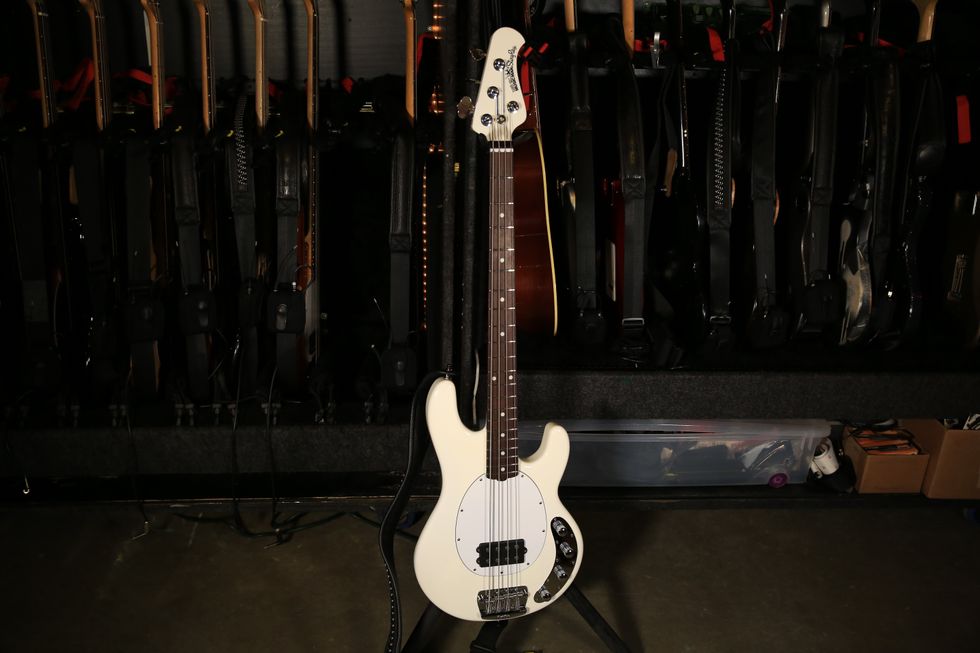
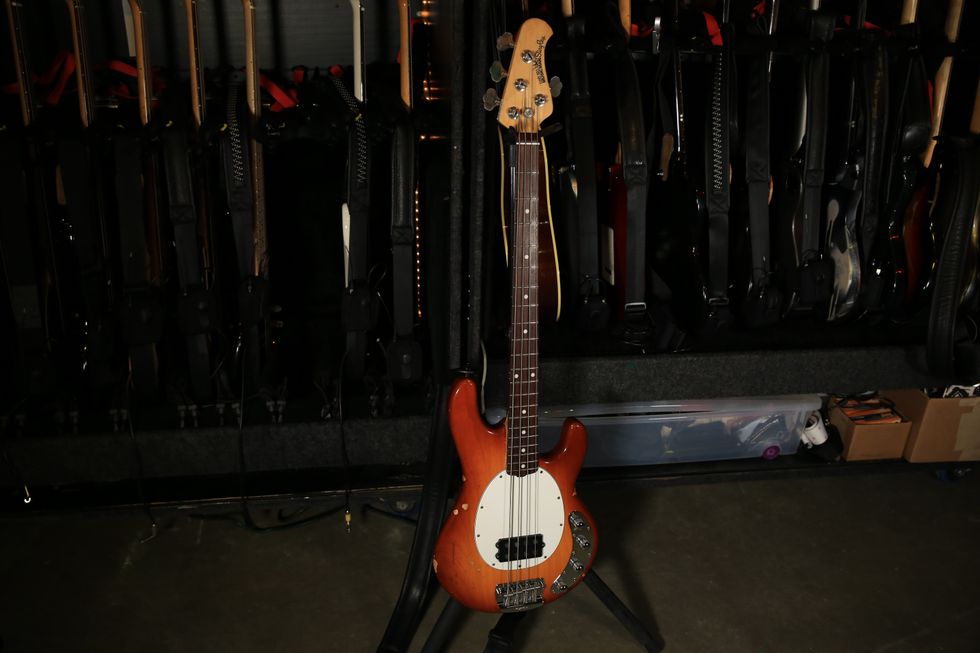
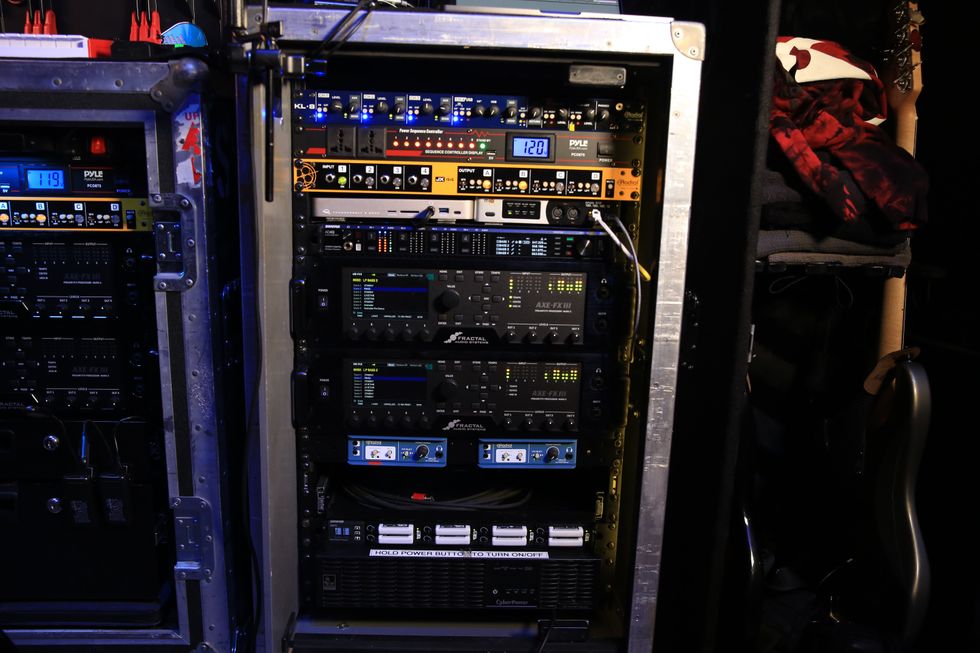

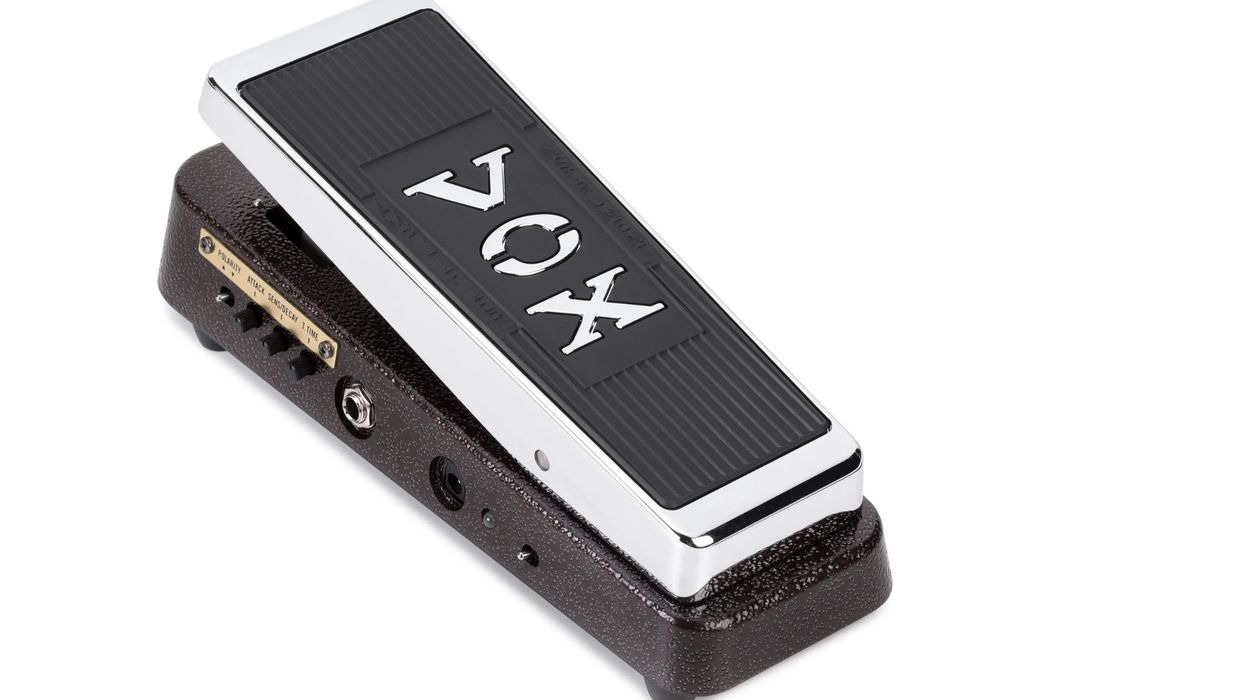
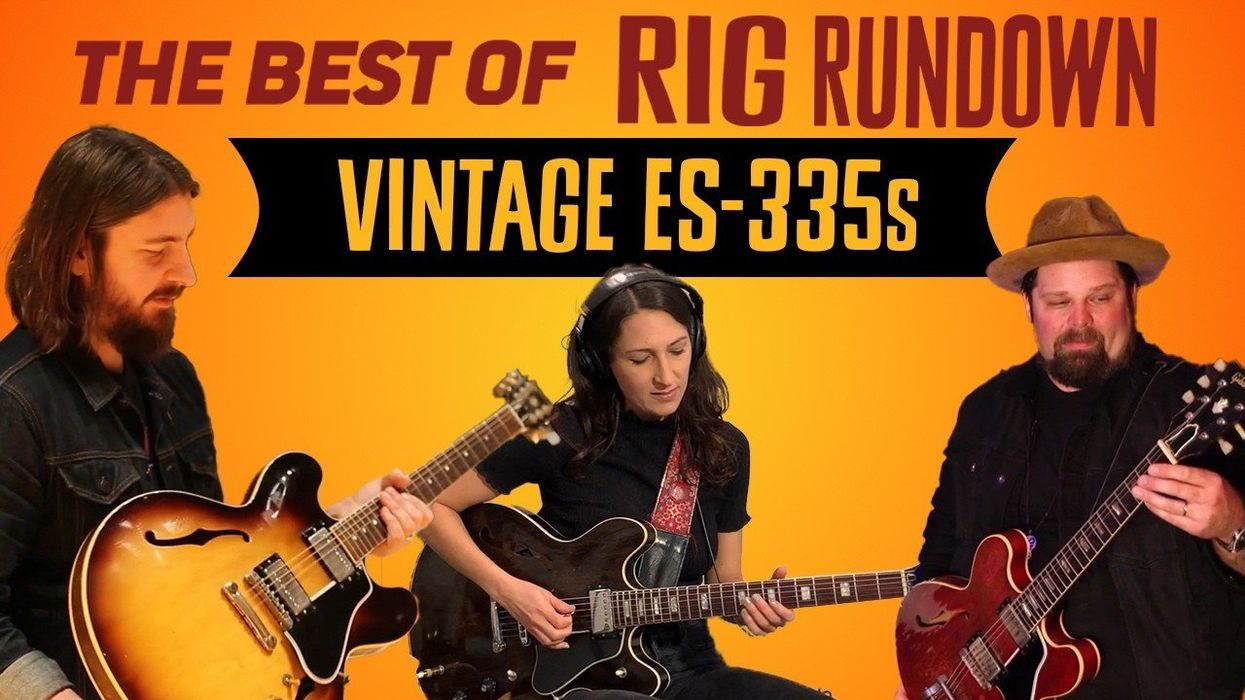
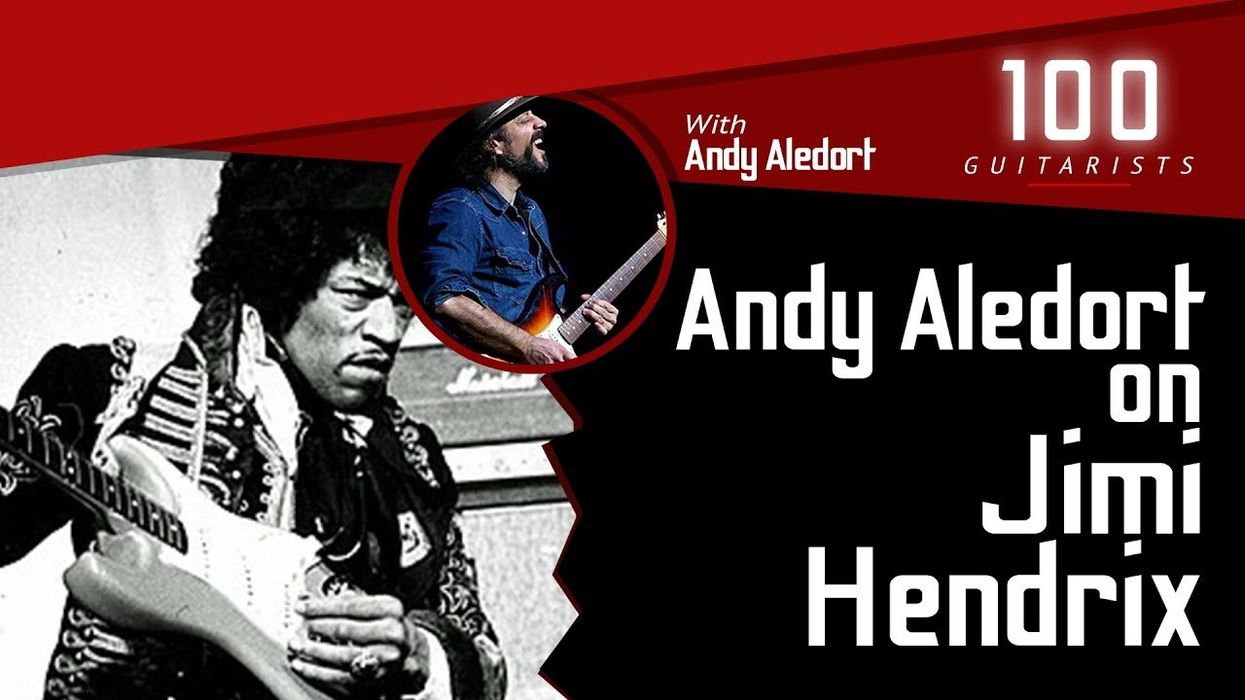
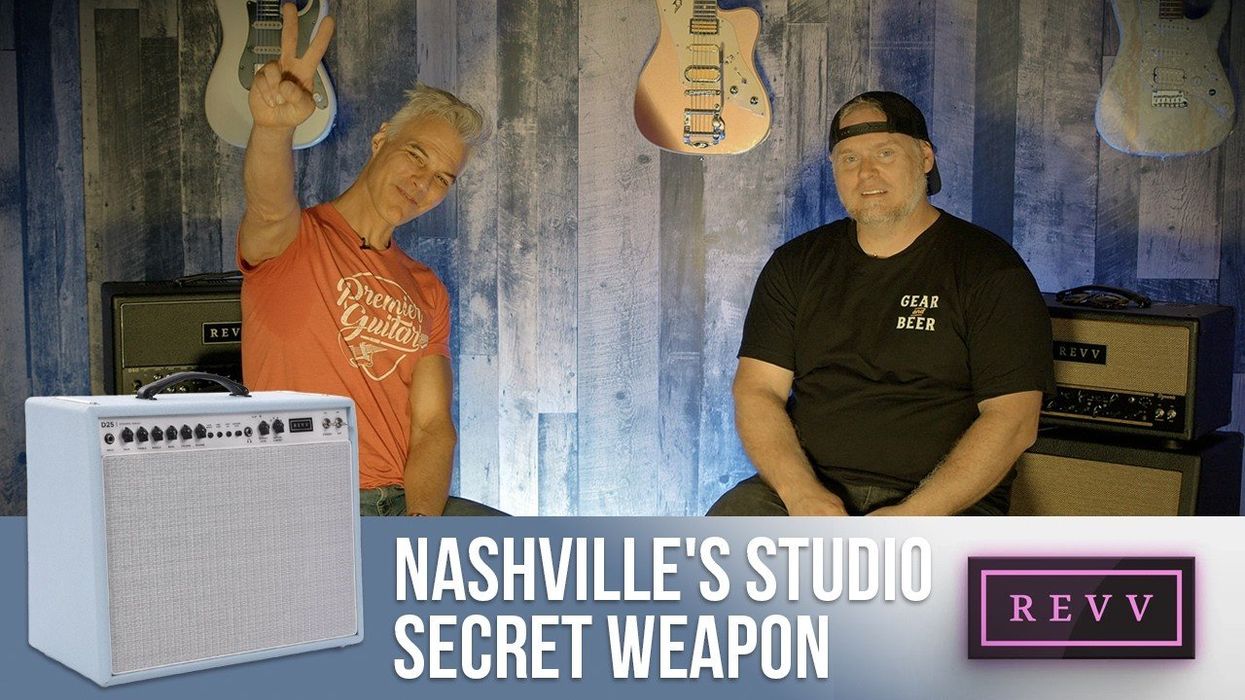


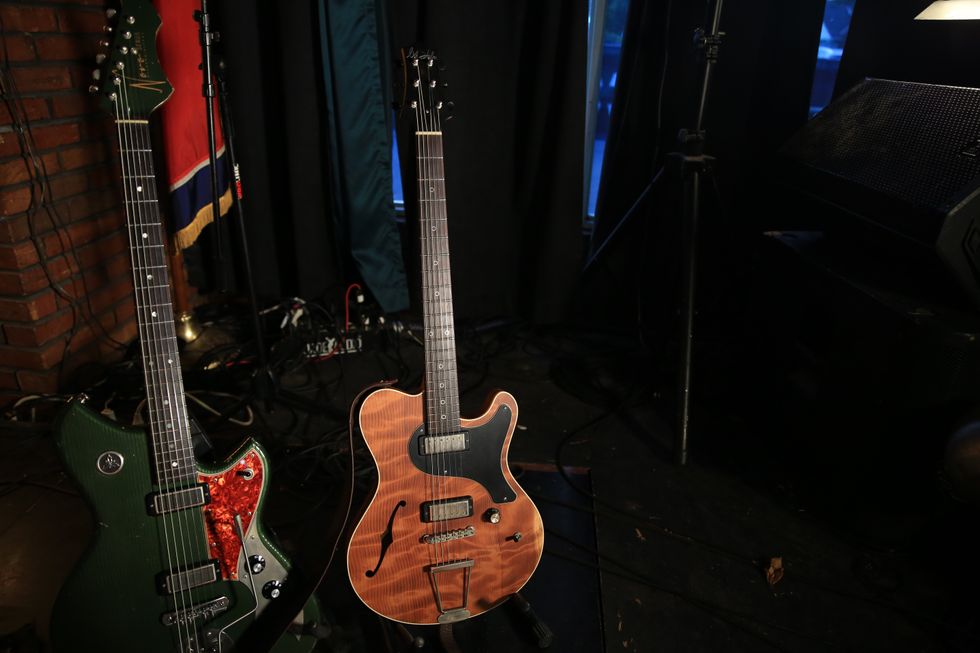
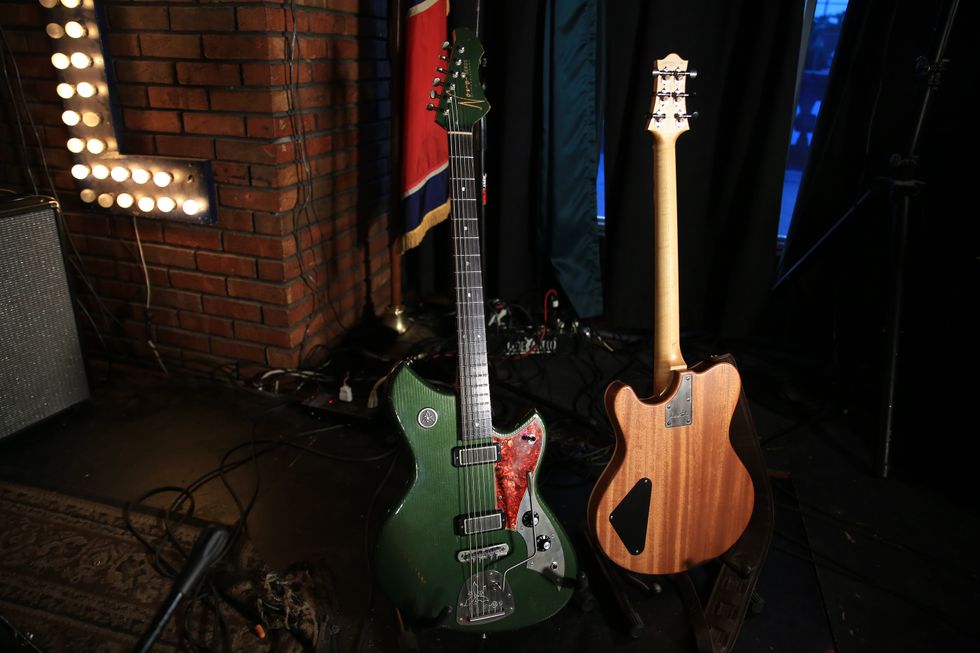
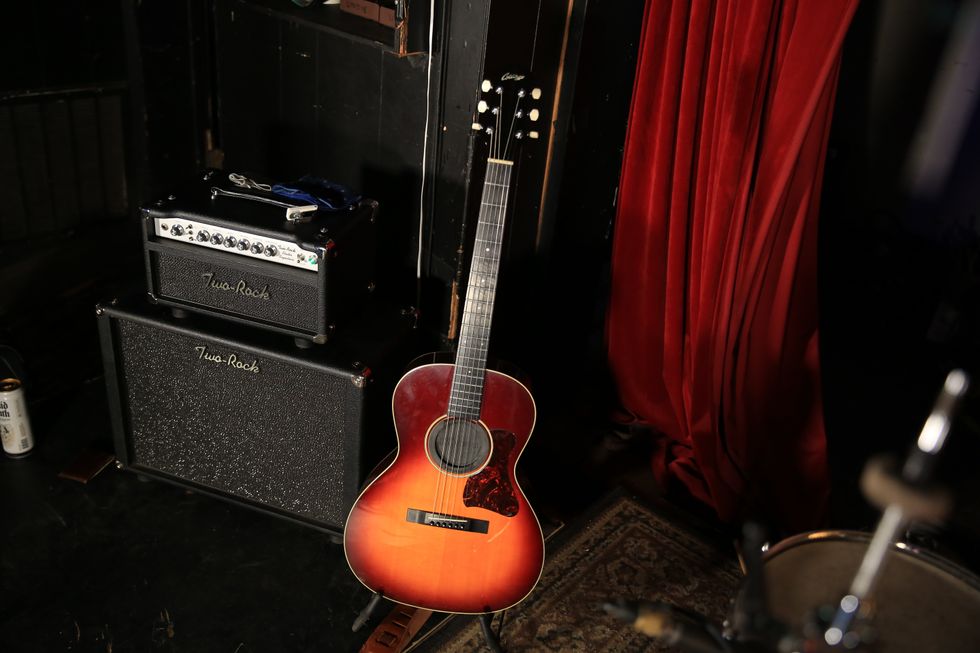
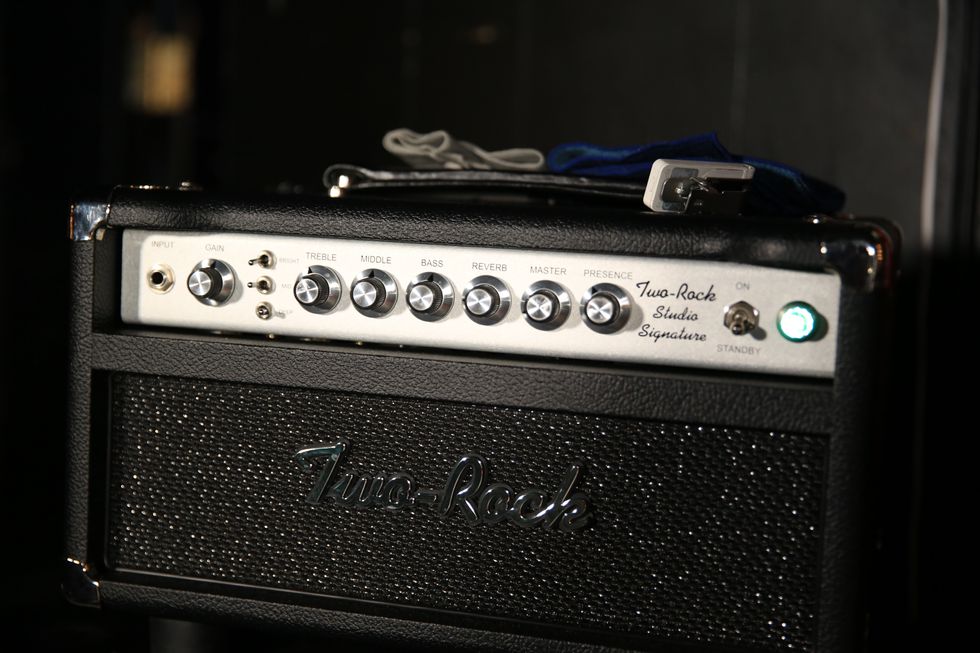
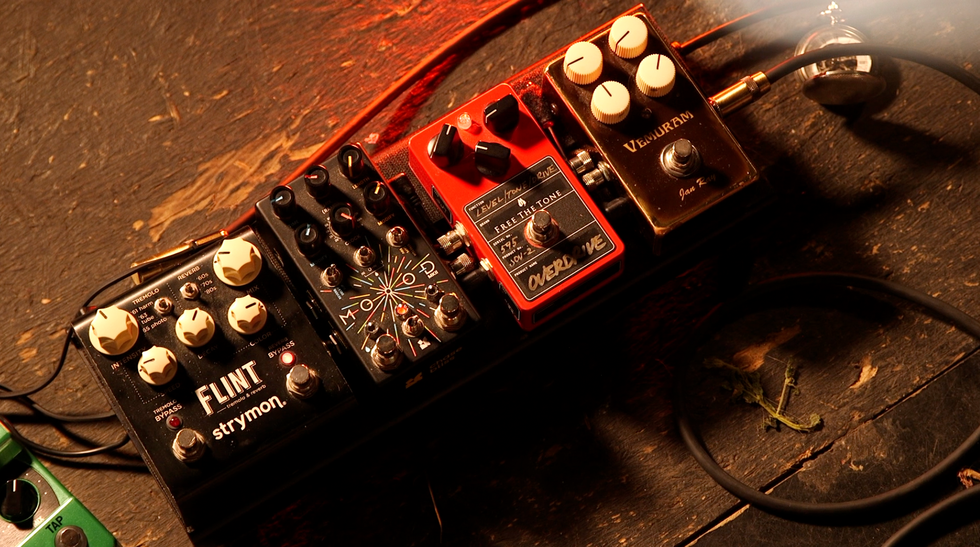
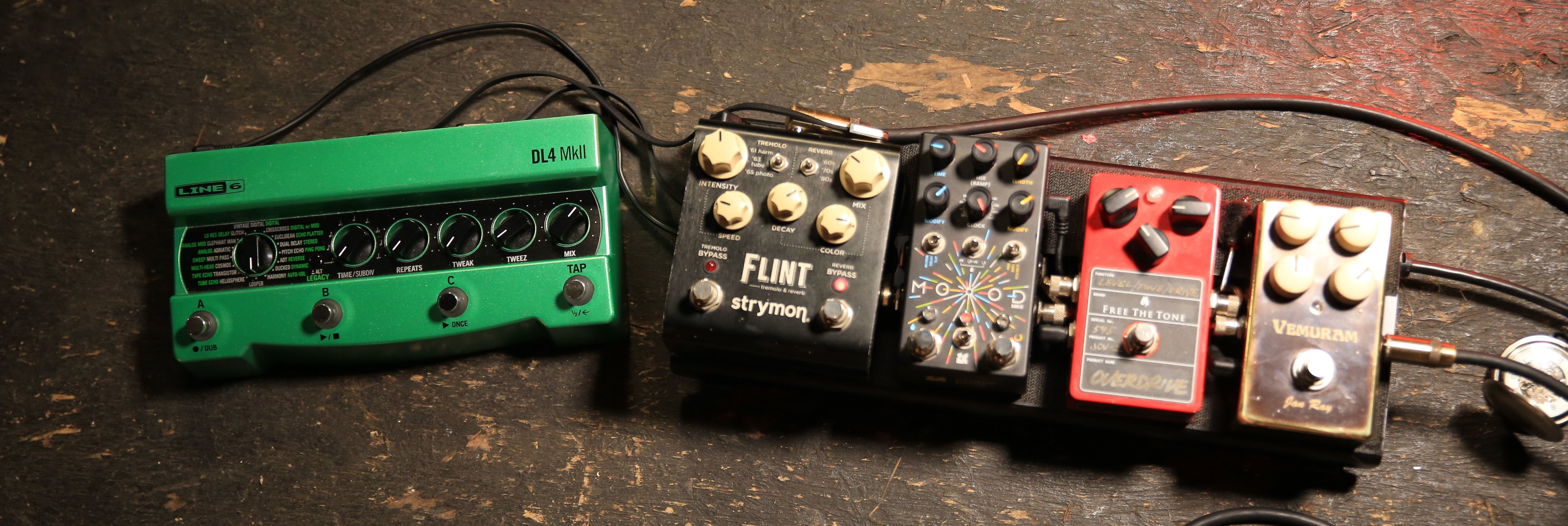 Miller’s Collings runs into a Grace Design ALiX preamp, which helps him fine-tune his EQ and level out pickups with varying output when he switches instruments. For reverb, sometimes he’ll tap the
Miller’s Collings runs into a Grace Design ALiX preamp, which helps him fine-tune his EQ and level out pickups with varying output when he switches instruments. For reverb, sometimes he’ll tap the 
